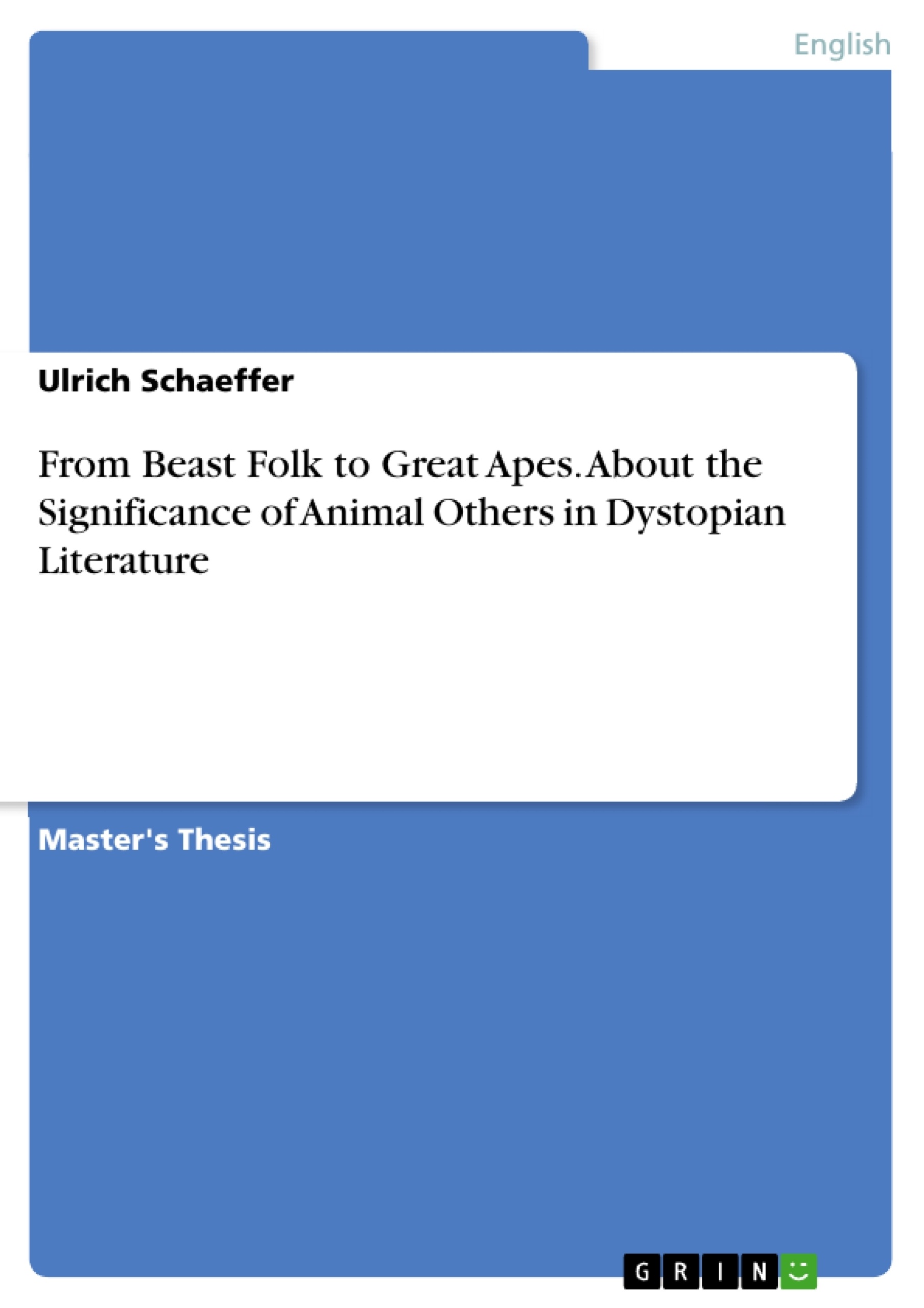Fictional animals constitute a unique literary device to let familiar things appear in a new light. Yet despite the fact that a number of dystopian texts utilise animals to convey manifold criticism, very little scholarly attention has been paid to this. The present research paper discusses the varied effects and overall significance of animal ‘Others’ in eight relevant dystopias from late Victorianism to Postmodernism in consideration of Edward Said’s ‘Otherness’. The results reveal that dystopian animal ‘Others’ represent a powerful tool to convey manifold social criticism. Moreover, most of the selected literature deconstructs animal ‘Otherness’ by jeopardising the otherwise generally unquestioned Western animal-human paradigm. This effect intensifies the dystopian impulse and, even more importantly, potentially sparks off a thought process that exposes the pejorative mechanisms underlying non-fictional ‘Others’. While real-life social out-groups may benefit from the emancipatory analogy, anthropological self-criticism by questioning one’s own judgmental authority appears to be even more significant.
Inhaltsverzeichnis
- Introduction: The Animal-Human Paradigm and Dystopian Literature
- The Theoretical Concept of the 'Other'
- The Depiction of Animals in Relevant Dystopias against the Backdrop of the 'Other'
- Animals within the Naturalistic Register
- Animals as Dramatis Personae
- Animal-Human Inversion
- Principal Effects of Utilising Animals in Dystopian Literature
- Questioning the Animal-Human Dichotomy
- Emphasising Inherent Human Vices
- Evil Human Nature
- Selfishness
- Questioning Human Culture and Society
- General Societal Criticism
- Animal Experiments and Abusive Animal Treatment
- Politics
- Exploitation and Racism
- Religion
- Anti-Utopian Criticism
- Conclusion: About the Overall Significance of Dystopian Animal ‘Others'
- Works Cited
Zielsetzung und Themenschwerpunkte
This master's thesis explores the significance of animal 'Others' in dystopian literature, analyzing how these representations contribute to the genre's critical and thought-provoking nature. The study examines eight dystopian texts from various periods, ranging from late Victorianism to postmodernism, to uncover the multifaceted effects of animal imagery in conveying social critique.
- The role of animal 'Others' in deconstructing the animal-human paradigm
- The use of animals to expose inherent human vices and societal flaws
- The impact of animal representations on questioning human culture and society
- The potential for dystopian animal 'Others' to spark self-reflection and challenge dominant perspectives
- The significance of animal 'Others' in intensifying the dystopian impulse and prompting critical engagement with real-world issues
Zusammenfassung der Kapitel
The introduction establishes the theoretical framework for the study, exploring the concept of the animal-human paradigm and its relevance to dystopian literature. It examines how the depiction of animals in dystopian texts can be understood through the lens of Edward Said's 'Otherness' theory.
Chapter 2 delves into the theoretical concept of the 'Other,' providing a comprehensive overview of its historical development and its application in literary analysis. It explores how the concept of 'Otherness' can be used to understand the representation of animals in dystopian literature.
Chapter 3 examines the depiction of animals in eight selected dystopian texts, analyzing their role in conveying social criticism and challenging the animal-human paradigm. It categorizes these depictions into three distinct registers: animals within the naturalistic register, animals as dramatis personae, and animal-human inversion.
Chapter 4 explores the principal effects of utilizing animals in dystopian literature. It examines how these representations contribute to questioning the animal-human dichotomy, emphasizing inherent human vices, and questioning human culture and society. This chapter delves into specific examples of how animals are used to critique societal issues such as animal experiments, politics, exploitation, racism, religion, and anti-utopian ideologies.
Schlüsselwörter
The keywords and focus themes of the text encompass dystopian literature, animal 'Others,' Edward Said's 'Otherness,' animal-human paradigm, social criticism, human vices, societal critique, animal experiments, politics, exploitation, racism, religion, and anti-utopian ideologies. The study examines the multifaceted ways in which animals are used as literary devices to convey complex social and ethical issues within the dystopian genre.
- Citation du texte
- Ulrich Schaeffer (Auteur), 2013, From Beast Folk to Great Apes. About the Significance of Animal Others in Dystopian Literature, Munich, GRIN Verlag, https://www.grin.com/document/288707
-

-

-

-
Téléchargez vos propres textes! Gagnez de l'argent et un iPhone X. -

-
Téléchargez vos propres textes! Gagnez de l'argent et un iPhone X. -

-
Téléchargez vos propres textes! Gagnez de l'argent et un iPhone X. -

-
Téléchargez vos propres textes! Gagnez de l'argent et un iPhone X. -

-
Téléchargez vos propres textes! Gagnez de l'argent et un iPhone X. -

-
Téléchargez vos propres textes! Gagnez de l'argent et un iPhone X. -

-
Téléchargez vos propres textes! Gagnez de l'argent et un iPhone X. -

-
Téléchargez vos propres textes! Gagnez de l'argent et un iPhone X. -

-
Téléchargez vos propres textes! Gagnez de l'argent et un iPhone X. -

-
Téléchargez vos propres textes! Gagnez de l'argent et un iPhone X. -

-
Téléchargez vos propres textes! Gagnez de l'argent et un iPhone X. -

-
Téléchargez vos propres textes! Gagnez de l'argent et un iPhone X. -

-
Téléchargez vos propres textes! Gagnez de l'argent et un iPhone X. -

-
Téléchargez vos propres textes! Gagnez de l'argent et un iPhone X. -

-
Téléchargez vos propres textes! Gagnez de l'argent et un iPhone X. -

-
Téléchargez vos propres textes! Gagnez de l'argent et un iPhone X.

